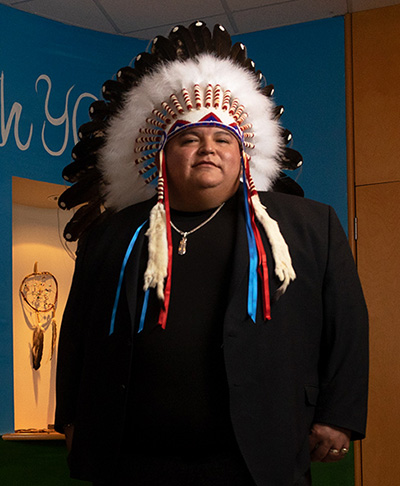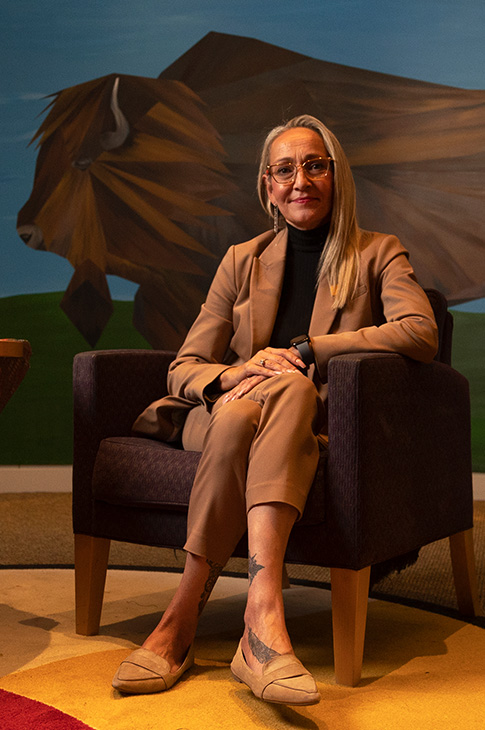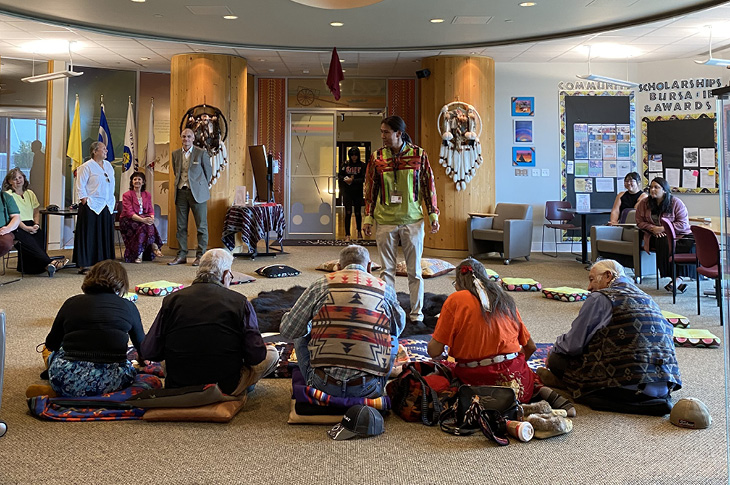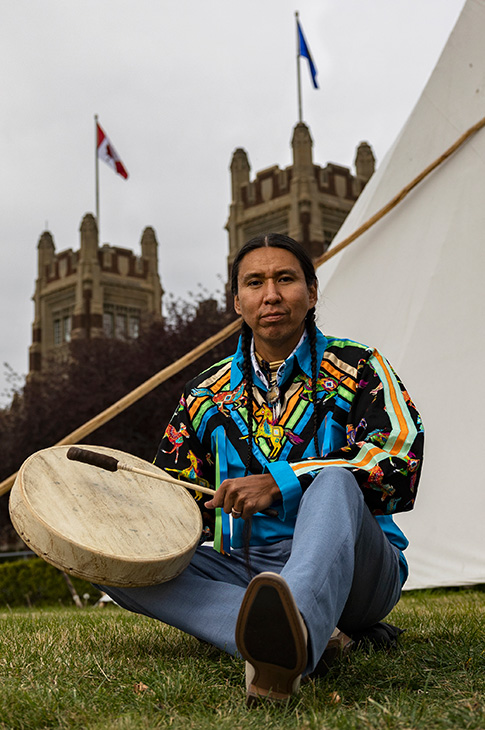
The first change Steve Kootenay-Jobin, Na’toya Piik’ski (Holy Bird), wanted to make when he started his role as manager of SAIT’s Indigenous student centre was its name — Chinook Lodge.
“Chinook is not a word in any Treaty 7 Nation language,” says Kootenay-Jobin, who is Îyârhe Nakoda. “The Lodge has been a hub for Indigenous and non-Indigenous students seeking support for more than 20 years, so I asked where the name came from. What does it mean, and how does it represent the students who have accessed the Lodge?”
It wasn’t obvious at first but, after a little digging, Kootenay-Jobin was able to find an article from the early 2000s while the Lodge was undergoing construction. It said the name was chosen by a student, but no other background was given.
So, less than one month after he started his role in December 2022, Kootenay-Jobin requested a name change for the Lodge.
“I felt strongly about changing the name because SAIT has a responsibility to community,” he says. “We are on the land of the Treaty 7 peoples, and our students need to be able to see themselves reflected within the institution.”
While SAIT agreed with his suggestion, Kootenay-Jobin says he found working within an institution steeped in colonial Western policies means decisions often have to travel through a hierarchy, and things take time to change.

The journey to truth and reconciliation
In 2015, the Truth and Reconciliation Committee of Canada made 94 Calls to Action to advance reconciliation efforts between Canadians and Indigenous Peoples. Significant roles for post-secondary institutions are outlined in several of those calls, including furthering reconciliation by integrating Indigenous knowledge and teaching methods into the classroom — part of a process known as Indigenization.
In 2019, SAIT launched its Indigenous Learner Success Strategy 2019/2021, a three-year plan intended as a first step in advancing its reconciliation efforts with Indigenous Peoples. In March 2023, Jennifer Russell, Ksikk inni na ki (White Buffalo Woman) (pictured left) joined SAIT in the newly created role of Director, Indigenous Engagement.
Russell, who is Cree and Blackfoot and a member of the Métis Nation of Alberta, says her job is to guide the SAIT community, including senior management, faculty and staff, through the journey of Indigenization and decolonization — a process of acknowledging the historical and ongoing impacts of colonization and residential schools on Indigenous peoples.
She’s also working with Kootenay-Jobin on creating an Indigenous strategic plan that will touch on academic policies, academic schools and programs campus-wide.
“The plan will work towards having curriculum connected to local history, building relationships with the Nations of Treaty 7 and having opportunities for on the land learning,” Russell says. “It will also look at having Elders in residence, more Indigenous faculty on campus, and direct recruitment and retention efforts for Indigenous students.
“Thinking long term, the strategic plan will even include Indigenous gardens — where traditional medicines can grow – and incorporating Indigenous languages throughout SAIT.”
As an example, Russell points to SAIT’s first Indigenous student convocation ceremony, held in June, which incorporated Indigenous protocols and teachings.
“I think SAIT has a good foot to stand on already, but my role is to look at where we are and where we want to be,” Russell says.
"Natoysopoyiis is 22 years old and has been a safe place for Indigenous students as they achieve their post-secondary goals and model intergenerational success for Indigenous people across Canada."
The path towards Indigenization
Indigenous worldviews require guidance from the community before change can happen. So when Kootenay-Jobin came to senior management with his name change suggestion, he explained that “before a baby is born, it doesn't know its name. Oftentimes the family and community give them their name.”
Names are regarded highly in Indigenous culture and are often gifted to people or places from Elders in the community. Kootenay-Jobin wanted to ensure this step towards Indigenization was done correctly, respectfully and within local traditions.
“We can't just pick a Blackfoot or Tsuut’ina word and say, ‘This is what we're going to call ourselves,’” he says. “There has to be a ceremony for a name to be transferred — often a pipe ceremony — led by traditional protocols and guidance from Elders.”
Once he had agreement from SAIT, Kootenay-Jobin now had to gather Elders from every Treaty Nation to address how the naming ceremony should proceed.
“Trying to bring together a group of Elders from across Treaty 7, on the exact same day, created quite a challenge,” he says. “I'm very early in my reclamation of ceremony and spiritual practices, and I made the task even more challenging by thinking that I needed pipe carriers from every single Nation.”
Though it was an honour to have five pipe carriers gather at the Chinook Lodge on one day, it was also a lesson in culture and protocols for Kootenay-Jobin. Since he had consulted first with Elder Miksiik’aam (Clarence Wolf Leg) of Siksika Nation — a member and recognized spiritual leader of the Blackfoot Confederacy — the Elders eventually decided they would follow a traditional Blackfoot style pipe ceremony.
Power in a new name
On July 18, 2023, staff from the Lodge and SAIT senior leadership shared the experience of a traditional Blackfoot pipe ceremony (pictured right) as the rights to be Lodge Keepers and to protect the space were transferred by the Elders to Kootenay-Jobin and Russell.
“That's when we had a name presented to us: Natoysopoyiis, which translates to Holy Wind Lodge,” Kootenay-Jobin says.
Pronounced nah-toy so-po-yees, it means how, during the winter and sometimes in summer, a quick wet snowstorm covers the ground and freezes. This sudden storm is sometimes referred to as siksopoo (covering windstorm). It blankets the ground and melts slowly bringing moisture to seeds under the ground. Old people sometimes call this a Holy Wind. This wind teaches us to prepare for unexpected weather changes, such as in life and unforeseen circumstances.

When Telly James Hunt (TV ’23), Blackfoot from Siksika and Kainai, learns of the new name, he says, “That Holy Wind that comes and gives the seeds moisture to grow — I really feel the name fits the Lodge because the people there help you deal with the unpredictability of Indigenous student life.”
He says the Indigenous student resource centre fills gaps other student centres may miss, and it understands the challenges facing Indigenous students in the city.
“Especially if you grew up on the reserve, you need every advantage you can get,” Hunt says. “Life for us is very unpredictable. On my reserve, we have deaths every week and it affects the community.”
He adds that education is an effective way for Indigenous peoples to help their communities on a larger scale.
A name can be a powerful thing, and Kootenay-Jobin believes that when Indigenous students feel strongly connected to their cultures and feel more pride within themselves, it will be reflected in Indigenous student retention and grade point average.
“These students are no longer wondering, ‘Do I belong here?’ Instead, they become a force to be reckoned with,” Kootenay-Jobin says. “And I believe the more we bring in cultural programming and create connections with Elders and Knowledge Keepers, the stronger students will become.”
“I will never forget that day,” Kootenay-Jobin says. “It was a critical lesson in recognizing that we have to be respectful of the different protocols, ceremonial practices and worldviews as we walk down this path towards Indigenization.”
Developing the Indigenous Strategic Plan
Now Kootenay-Jobin is looking forward to the next pipe ceremony — when the Indigenous strategic plan is developed. That plan will give direct deliverables, outline specific outcomes and provide measurables so all of SAIT can easily stay on the path towards Indigenization.
“We’ll be able to bring in Knowledge Keepers and Elders to teach co-curricular activities and really help retain the traditions and the customs of the local people,” says Kootenay-Jobin. “But it also gives our non-Indigenous students the knowledge so they're well equipped to go into the world and work with Indigenous peoples.”
Kootenay-Jobin believes the strategic plan will symbolize a huge decolonization effort and the revitalization of Indigenous customs and practices.
“We're not just Indigenizing or decolonizing campus for the 415 First Nations, Métis and Inuit students and 85 apprentices registered at SAIT in this Fall term,” he says.
And, Russell says, “We are very close to introducing SAIT-wide training on Indigenous history to help meet the Truth and Reconciliation Committee’s Calls to Action for understanding residential schools, Treaties, the Indian Act, anti-racism, and the contributions of Canada’s Indigenous Peoples.
"I want to uphold that beauty, integrity and humility in how we engage in relationships with all people."
A space to be seen, heard and supported
Brandy Sangwais, Saulteaux Cree from Zagime Anishinabek, southern Saskatchewan, is a graduate from the Horizons program and is currently working on her degree in business through SAIT. She also owns her own beauty and fashion line, Legendary Beauty and Cosmetics.
“As an adult learner, I’m showing my children that it's never too late to continue your education or training,” she says. “As Indigenous people, we have support through the Lodge and a community that will support us in our education journey.
“When I come into the Lodge, I'm able to smudge and pray with access to Elders and ceremony, and that has really helped me throughout my program.”

A keeper of knowledge
Cultural safety is something Thomas Snow (pictured left), Knowledge Keeper, feels when he steps into Natoysopoyiis. “I feel at home,” he says. “I feel safe when I step in here. And it takes a lot of work, thought and care to create a space like that.”
A Knowledge Keeper has been taught by an Elder or a senior Knowledge Keeper within their community; holds traditional knowledge and teachings; and has been taught how to care for these teachings and when it is appropriate to share them. At the Lodge renaming ceremony, Snow offered ceremonial knowledge and supported cultural protocols.
At first, Snow felt the job would be perfect for his Elders. But, when Snow asked his Elder for guidance, he was reminded his knowledge had been taught to him to carry on important work through his passion, intelligence and youthful spirit. Snow is dedicating his life to carrying on the customs and practices of his ancestors while passing on the teachings and growing as a leader in a humble way.
“It's a deep understanding that comes from a lifetime of practice. At its essence is a search for truth and greater meaning in life. I've had the privilege of growing up around those Elders and community members who sought that learning and mentored me. I'm honoured to be part of this process and invited into such a beautiful space. I want to uphold that beauty, integrity and humility in how we engage in relationships with all people.”
Reconnecting with culture
“There are so many intersections between Equity, Diversity and Inclusion (EDI) and Truth and Reconciliation, and they all land on equity,” Russell says. “Human equity and treating each other how we want to be treated — or how we would treat our grandmothers — is a really good way to create a space.”
She believes SAIT has the potential to be the safest place for Indigenous students entering education. "Natoysopoyiis is 22 years old and has been a safe place for Indigenous students as they achieve their post-secondary goals and model intergenerational success for Indigenous people across Canada."
Though Indigenous cultures and traditional practises have been invalidated and prohibited through the act of colonization, Indigenous communities are resilient. They have the ability to heal, and Indigenous peoples continue to maintain a relationship with the land and each other.
“It's not rocket science, but because of a lot of colonial structures, it often sounds like rocket science,” says Russell. “But it's a very simple way of living and knowing.
“I look at SAIT as the future workforce. SAIT is where industry leaders are created,” she says. “The Indigenous strategy is part of the Indigenization and decolonization strategy, but it's so much bigger than that because of the hearts and minds that sit in those seats. They’re going to have a great impact on the world.”
Keith Driver, Métis Cree, (BN ’23) says he used Natoysopoyiis as a student to reconnect with his culture.
“Being able to sit and talk and engage with other Indigenous people helped me reconnect with something that I knew was missing in my life,” he says. “For me, going into the Lodge reminded me of [being at] my Kokum’s; my grandmother's — the smell of sage and sweet grass — this is a place of gatherings and a
place of peace.”

Oki, Âba wathtech, Danit'ada, Tawnshi, Hello.
SAIT is located on the traditional territories of the Niitsitapi (Blackfoot) and the people of Treaty 7 which includes the Siksika, the Piikani, the Kainai, the Tsuut’ina and the Îyârhe Nakoda of Bearspaw, Chiniki and Goodstoney.
We are situated in an area the Blackfoot tribes traditionally called Moh’kinsstis, where the Bow River meets the Elbow River. We now call it the city of Calgary, which is also home to the Métis Nation of Alberta.